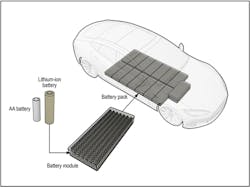NTSB Report Addresses Safety Issues Related to Lithium-Ion Battery Fires
WASHINGTON — The National Transportation Safety Board issued four safety recommendations Wednesday based on findings contained in Safety Report 20/01 which documents the agency’s investigation of four electric vehicle fires involving high-voltage, lithium-ion battery fires.
Three of the lithium-ion batteries that ignited were damaged in high-speed, high-severity crashes, and the fourth lithium-ion battery fire occurred during normal vehicle operations. All three of the crash-damaged batteries reignited after firefighters extinguished the vehicle fires. The battery in the fourth investigation did not reignite.
Safety Report 20/01 identified two main safety issues through its investigation:
- The inadequacy of vehicle manufacturers’ emergency response guides.
- The gaps in safety standards and research related to high-voltage lithium-ion batteries involved in high-speed, high-severity crashes.
Actions sought by the NTSB in the four safety recommendations issued Wednesday include:
- Factoring the availability of a manufacturer’s emergency response guide, and its adherence to International Organization for Standardization standard 17840 and SAE International recommended practice J2990, when determining a U.S. New Car Assessment Program score.
- Continued research on ways to mitigate or deenergize stranded energy in high-voltage lithium-ion batteries.
- Continued research on ways to reduce the hazards associated with thermal runaway resulting from high-speed, high-severity crashes.
- Manufacturer emergency response guides modeled on ISO standard 17840 and SAE International recommended practice J2990.
- Incorporation of vehicle-specific information in emergency response guides for: Fighting high-voltage lithium-ion battery fires.
- Mitigating thermal runaway and the risk of high-voltage lithium-ion battery reignition.
- Mitigating risks associated with stranded energy in high-voltage lithium-ion batteries during emergency response and before a damaged electric vehicle is removed from the scene.
- Safely storing an electric vehicle with a damaged high-voltage lithium-ion battery.
- Providing information and available guidance to first responders and other crash scene workers about fire risks associated with high-voltage lithium-ion battery fires in electric vehicles.
Fires in electric vehicles powered by high-voltage lithium-ion batteries pose the risk of electric shock to emergency responders from exposure to the high-voltage components of a damaged lithium-ion battery. A further risk is that damaged cells in the battery can experience thermal runaway – uncontrolled increases in temperature and pressure – which can lead to battery reignition. The risks of electric shock and battery reignition/fire arise from the “stranded” energy that remains in a damaged battery.
The National Transportation Safety Board has an interest in the safety of emerging technology, including alternative vehicle fuel sources such as lithium-ion batteries. Safety issues with the high-voltage, lithium-ion batteries used in electric vehicles first gained widespread attention when a Chevrolet Volt caught fire three weeks after a crash test in May 2011.
The NTSB’s first investigation of electric vehicle battery fires on US roadways was in 2017, when a high-voltage lithium-ion battery caught fire after an electric vehicle left the road and crashed into a residential garage at high speed.
Between 2017 and 2018 the NTSB investigated two other electric vehicle high-speed, high-severity crashes that resulted in post-crash fires and one non-crash fire. During the course of its investigations, the NTSB considered the safety risks to first and second responders posed by the vehicles’ high-voltage, lithium-ion batteries. Those risks are addressed in the NTSB’s Safety Report 20/01, “Safety Risks to Emergency Responders from Lithium-Ion Battery Fires in Electric Vehicles.”
To highlight the lessons learned in Safety Report 20/01 the NTSB produced a short video that is available on the NTSB’s YouTube Channel at https://www.youtube.com/watch?v=J6eS6JzBn0k.
Safety Report 20/01 is available online at https://go.usa.gov/xAEyP.
###
The National Transportation Safety Board (NTSB) is an independent federal agency charged with determining the probable cause of transportation accidents, promoting transportation safety, and assisting victims of transportation accidents and their families.
